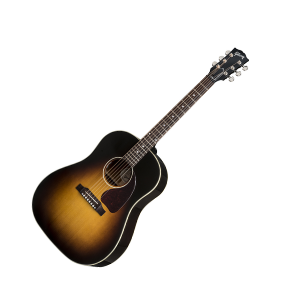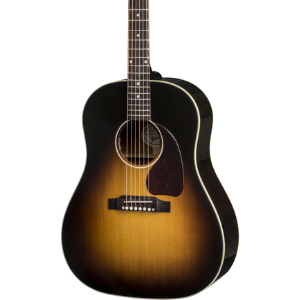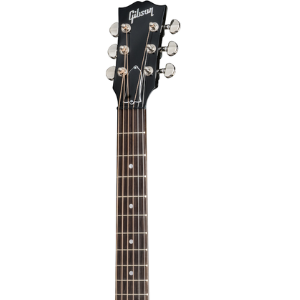- Home
- Instruments
- Gear
- Recording
- Lessons
- Reviews
- Blog


| Body And Neck: |  |
| Electronics: |  |
| Hardware: |  |
| Sound: |  |
| Value: |  |
For all the fame of Gibson's electric guitar designs, the company possesses a similarly rich heritage when it comes to acoustic guitars. The company is known for its “jumbo” series of round-shouldered dreadnoughts — the large bodies provide deep, sonorous bass with clear mids and highs.
Out of all of Gibson's acoustic guitars, the J-45 is the best-selling model of all time. Since its introduction in 1942, it's become a classic design with the sound to match. The electronic capabilities in the new standard J-45 only add to the bargain. Let's take a closer look at the details and break down what makes the J-45 one of the best premium acoustic-electric guitars on the market.
 Body and Neck
Body and NeckAs we mentioned above, the J-45 is part of Gibson's “jumbo” lineup. The jumbo body shape is similar to the famed dreadnought style of Martin and other manufacturers, but the jumbo includes more rounded, sloped shoulders and slightly smoother curves to keep you comfortable as you play. The body itself uses a AAA-grade solid Sitka spruce top. Sitka is a renowned acoustic tonewood thanks to its clarity and punch, and the AAA-grade top here is one of the highest-quality pieces you'll find on any guitar.
The rest of the body uses mahogany. While mahogany is brighter than rosewood, it's still darker and more reserved in tone than spruce; together the two form a classic combination that's used in plenty of premium acoustic models. The neck, which is also made of mahogany, houses a rosewood fingerboard. Gibson boasts that the “slim taper” neck shape is easy to play for electric and acoustic guitarists alike.
Unlike many other manufacturers who adopt a 25 1/2″ scale, Gibsons use a 24 3/4″ scale. The smaller length isn't enough to make the J-45 unusable for guitarists with thicker fingers, but it does make a noticeable impact. The strings feel slinkier, and it's easier for players with smaller hands to maneuver up and down the board.

Though it's tucked away out of sight, the J-45 carries an L.R. Baggs VTC pickup on board. This pickup lies underneath the saddle, with a small interface attached to the top side of the soundhole. Under-saddle pickups are often maligned for “dampening” and compressing a guitar's natural tone, though the premium VTC on this model does a better job than most of preserving the natural tone.
The soundhole control setup allows you to manipulate your guitar's electric volume and tone without needing to access your amp or DI. Unlike other acoustic-electric interfaces, the J-45 doesn't include any knobs or dials on the exterior of the guitar — a sleek touch that many players will love.
The J-45 features all of the premium hardware you might expect from a Gibson Standard guitar. This guitar's interior bracing is a real highlight — it's formed in a hand-scalloped “X” shape to increase sustain and resonance from the soundboard.
The bridge is made of rosewood, like the fretboard, with a Tusq saddle and bridge pins. Those bridge pins are weighted; while this may seem like a small detail, the extra material makes a difference in string sustain. Across the other end of the neck, you'll find a black nut and a set of Grover nickel closed-gear Rotomatic tuners. They're easy to operate, precise, and keep your tuning stable.
Though it might look similar to guitars like Martin's D-18 or even one of Taylor's 500-series instruments, the J-45 has a voice all its own. It's precise and balanced, with more of an emphasis on the midrange and treble than other large acoustics. The mahogany contributes to the J-45's character — the bass is warm and smooth rather than booming, and the midrange is significantly thicker than guitars made with rosewood for the back and sides.
That brighter, mid-heavy character makes the J-45 great for playing lead work, though it's versatile enough to handle pretty much any task. It's also a fantastic guitar to use a capo with, as it places a bit more emphasis on the treble end of the range.
When run through the onboard pickup, the J-45 is a good guitar for stage gigs. It's still bright and charismatic, though there is some noticeable dampening and electronic color on the sound. Thankfully, it's not a deal-breaker; the tone is more natural with this than with most other acoustic-electric guitars. The electronic dampening is most noticeable when palm-muting strums or abruptly cutting off chords — if you're a hard player or strum your acoustic exclusively, you might find that an outboard mic will offer you better sound.
The Gibson J-45 is a workhorse acoustic-electric that's equally at home on stage and in the studio. After all, there's a reason it's endured since 1942! If you're willing to pay top dollar for a premium acoustic but still want a well-balanced model that can do pretty much everything well, you should check out this guitar.

Reader Interactions